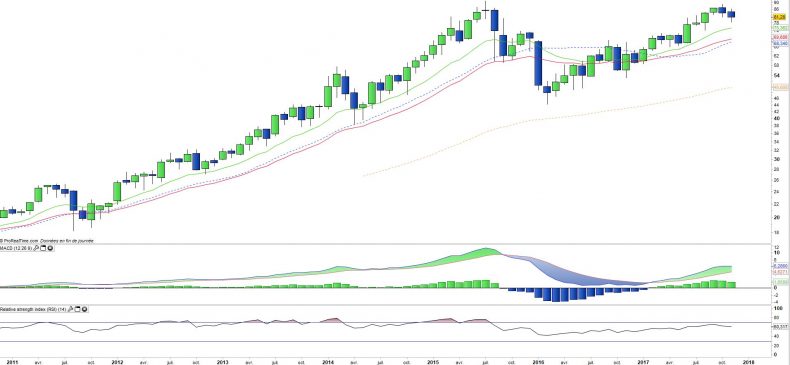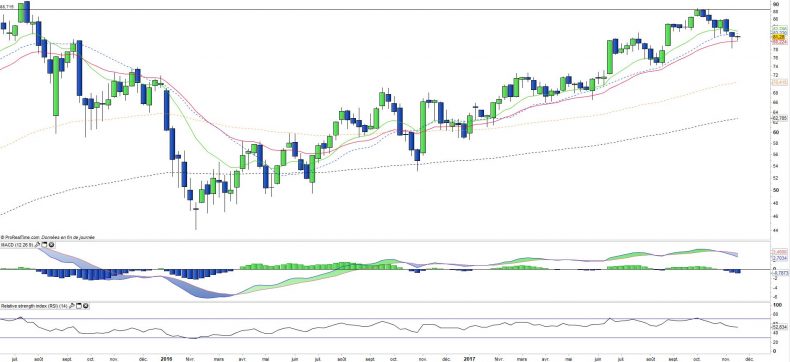SPDR S&P Biotech - XBI - 22/11/2017
Short Term strategy : Neutral (50%) / Trend -
Long Term strategy : Positive (95%) / Trend =
Characteristics of the ETF
The XBI ETF (SPDR) created in 01/2006 replicates an index based on a selection of 102 specialized stocks in biotechnology. The tracked index is the S&P Biotechnology Select Industry Index. This is a very specialized index from a geographical point of view, composed mainly of US stocks and quoted in USD.
The fee for this ETF is 0.35% and the AUM is approximately $ 4098M. The replication method is direct and there is a dividend distribution policy on a quarterly basis.
Alternative ETFs: IBB (Ishares in USD), FBT (First Trust Amex in USD), BBH (VanEck Vectors in USD)
Index & components
The Biotech XBI ETF (SPDR) offers interesting intrinsic characteristics because of its less concentrated weighting on the sector stars like Biogen or Amgen.
XBI is a very deep ETF whose first 10 lines represent only 23% of the capitalization. It is thus a very diversified product and not biased by an overrepresentation of the big values, which seems to us fundamental for a growth sector where giants can be born in a few years in the event of a blockbuster.
Expected earnings growth over a period of 3-5 years is estimated at 18.9% for a 2018 PER of only 16x, which is lower than that of the S&P500 (19x). The biotech sector lends looks particularly well adapted to an ETF logic that makes it possible to pool risks, rather than focusing on a specific company, which can be very risky. As a whole, if the sector produces many innovative molecules, disappointments can also be the key, with in both cases extreme market reactions because these companies are often valued in relation to only 1 or 2 promising molecules. The interest of XBI is to be fairly representative of the US Biotech industry and that it is also very attractive in terms of valuation given the expected growth rate over 3-5 years and the long-term potential of the industry.
The US campaign has left a legacy, with controversies over the price of drugs deemed too high, leading to a certain lack of visibility on the sector, but these threats do not seem to have to be followed by actions for the moment. We consider that the price of drugs tends to fall on the old molecules (via generics), but are unlikely to apply on the new ones which would have the effect of penalizing research in a sector where the US is in the forefront . This will probably not happen.
The Biotech sector can be volatile, with very large price variations even if the long-term orientation remains favorable. However, it is also a high-growth sector, with little dependence on the economic cycle, so the sector had held up well during the 2008 financial crisis compared to the S&P500. Volatility must therefore be used during the consolidation phases (as at the end of 2016), while the sector is also often subject to overheating, so it is also necessary to know how to take profits when the multiples become irrational as it was the case in 2015.The political uncertainties and lack of visibility on the Trump administration's health policy remain a drag on the expansion of the sector.
Latest developments
The performance of XBI is + 36.6% since the beginning of the year, more than twice the S&P500 (+ 15.3%), after a sharp drop -15.7% in 2016, which followed an overheating and corresponded to a marked consolidation after a very significant increase cycle between 2010 and 2015, which saw XBI's prices increase five-fold over the period. More fundamentally, the year 2016 was also disappointing from an R & D perspective, with fewer drugs successfully obtaining FDA approval and many companies suffering from large pipeline failures.
So far in 2017, the FDA has approved 34 new drugs, surpassing the total of 22 last year and many more are expected to be involved in key therapeutic areas such as immuno-oncology, Alzheimer's disease, central nervous system disorders and immunology / inflammation. However, while M & A expectations were high for 2017, this has not been confirmed yet. The sector could take off if more mergers and acquisitions were to occur, but companies seem to be adopting a wait-and-see attitude while waiting for more clarity on the medicine prices policy and tax reforms. Another major deterrent remains the potentially high valuations in some specialties, which may lead to overvalued transactions.
Monthly data
The monthly chart shows that the 2016 correction has been fully erased and that the underlying bullish trend has resumed. However, XBI is facing significant resistance in the $ 90 zone, which is the peak of 2015. Once this difficulty is overcome, new highs should ensue. A consolidation is under way towards the moving averages 13E & 26E, which makes it possible to rebuild the buying potential.
The technical oscillators are far from overbought, which leaves a lot of upward potential.
Weekly data
On the weekly chart, we can see a short term correction, within a medium-term uptrend. The prices came to test the EMA26 which is a solid support to cause a rebound. The prices are at a convenient place to stop this consolidation, as has been the case several times.
The oscillators moderately correct and stay in the high zone confirming the underlying uptrend.
ETF Objective
XBI is an ETF which seeks to replicate (before fees) the total return performance of the S&P Biotechnology Select Industry Index (102 companies)
Characteristics
| Inception date | 31/01/2006 |
| Expense ratio | 0,35% |
| Benchmark | S&P Biotech Select Industry Index |
| Ticker | XBI |
| ISIN | US78464A8707 |
| Issuer | SPDR |
| Currency | $ |
| Exchange | NYSE |
| Assets Under Management | 4 098 M$ |
| Replication method | Physical (Direct) |
| Dividend | Distribution |
| Currency risk | No |
| Number of Holdings | 102 |
| Risk | 3/5 |
Country Breakdown
| USA | 100% |
Sector Breakdown
| Biotechnology | 100% |
Top Ten Holdings
| Alnylam Pharmaceuticals | 3% |
| Juno Therapeutics | 3% |
| Exact Sciences Corporation | 3% |
| Bluebird bio Inc. | 3% |
| Sarepta Therapeutics | 3% |
| Neurocrine Biosciences | 2% |
| Seattle Genetics | 2% |
| AbbVie Inc | 2% |
| United Therapeutics Corp. | 2% |
| AveXis Inc. | 2% |


